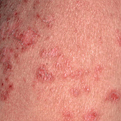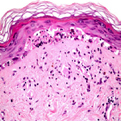Discoid Lupus Erythematosus
General Information
Discoid Lupus Erythematosus (DLE) is a chronic skin condition that develops circular inflamed red patches with a scaling and crusty appearance, ranging from 5-10 mm in diameter. The sores are usually located on the face, ears and scalp; at times, they may be found on other parts of the body. When the lesions occur on an area that has hair, scarring and hair loss can take place. The condition is thought to be autoimmune with the body’s immune system incorrectly attacking various tissues of the body believing they are foreign invaders. Treatment is to improve the appearance of the lesions. Therapy begins with sun-protective measures which include sunscreens and protective clothing when outside. A health-care provider may recommend Cortisone ointments or injections, calcineurin inhibitors, pimecrolimus cream or tacrolimus ointments.
Epidemiology
17-48 cases per 100,000 populations, seen mainly in patients aged 40-60 years, occurring three times more frequently in females then in males
Etiology
Unknown; Linked to genetic predisposition and autoimmune
Pathogenesis
Begins as erythematosus plaques and progress to atrophic scars
Clinical
Circular inflamed red patches with a scaling and crusty appearance
Histology
Vacuolar alteration of the basal cell layer, thickening of the basement membrane, follicular plugging, hyperkeratosis, atrophy of the epidermis, incontinence of pigment, and inflammatory cell infiltrate (usually lymphocytic) in a perivascular, periappendiceal, and subepidermal location
Bibliography
1. “Lupus Erythematosus, Discoid” (Online). June 2007. http://www.emedicine.com/DERM/topic247.htm (visited: March 24, 2008) 2. “Discoid Lupus Erythematosus” (Online).http://www.aocd.org/skin/dermatologic_diseases/discoid_lupus_eryt.html (visited: March 24, 2008)
Download PDF
![]() Discoid Lupus Erythematosus
Discoid Lupus Erythematosus


